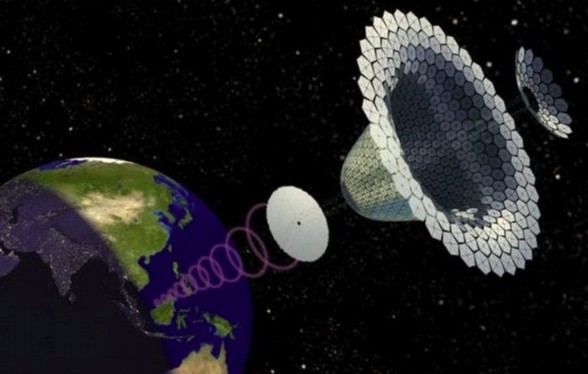If we could power such an elevator with solar energy, we could simply rise up into space for a fraction of the cost of a trip by rocket or shuttle.
如果我們能用太陽能給電梯供能,我們就能直接升上太空,成本不過是火箭或太空船之旅的一小部分。
But wait, elevators don't just rise up.
等等,電梯不是自己就會升上去的。
They have to hang on some kind of wire or track or something.
電梯要懸掛在纜線或軌道或別的什么上。
Uh, true. And for decades that's exactly what's prevented the idea from being feasible or even just taken seriously—where do we find the material strong enough yet lightweight enough to act as a cable or track.
對。幾十年來,這正是這種設想不可行或不被嚴肅對待的原因——我們上哪里去找出一種強度足夠高的材料來做纜線或軌道呢?
I mean, we are talking 36,000 kilometers here.
我們說的可是三萬六千公里啊。

And the strain on the cable would be more than most materials could bear.
纜線上的張力對于大多數材料來說都太大了。
But a new material developed recently has a tensile strength higher than diamond, yet it's much more flexible.
但最新開發出了一種新材料,其抗張強度比鉆石還高,而且更柔韌靈活。
I am talking about carbon nanotubes.
我說的是碳納米管。
OK. I've read something about carbon nanotubes.
我看過一些關于碳納米管的資料。
They are strong, alright, but aren't they just very short little cylinders in shape?
碳納米管強度是很高,但它們的形狀不是很短小的圓柱體嗎?
Ah, yes. But these cylinders cling together at a molecular level.
啊,對。但從分子水平上看,這些圓柱體都是緊密結合在一起的。
You pull out one nanotube or row of nanotubes, and its neighbor's come with it, and their neighbors, and so on.
你取出一個納米管,或一排納米管,它們的鄰居(相鄰的納米管)也會隨之取出,還有鄰居的鄰居等等。
So you could actually draw out a 36,000-kilometer strand or ribbon of nanotubes stronger than steel, but maybe a thousandth the thickness of a human hair.
所以,你真的能夠拉出一條三萬六千公里長的納米管線,或者納米管帶,其強度比鋼鐵要高,但其厚度可能只是人類頭發的千分之一。
OK. Fine. But what's going to hold this ribbon up and keep it reach enough to support an elevator car?
好吧。但要用什么來支撐這條納米管帶,讓它能伸得足夠遠來支撐升降機呢?
Well, we definitely have to anchor it at both ends.
肯定是兩端都要固定住的。
So what we need is a really tall tower here on the ground right at the equator and a satellite in geostationary orbit around the Earth.
所以我們需要赤道地面一個非常高的高塔,和沿地球靜止軌道繞地運轉的衛星。
There's a reason I mentioned that figure of 36,000 kilometers.
這是我提到三萬六千公里這個數字的原因。
That's about how high an object would have to be orbiting straight up from the equator to constantly remain directly above the exact same spot on the rotating planet Earth.
一個物體要想在赤道正上方繞軌運轉,且一直保持在自轉地球的正上方的同一位置,該物體就要達到這個高度。
So once you are in this geostationary orbit right over the tower, just lower your carbon nanotube cable down from the satellite, tether it to the tower here on Earth.
一旦你在塔正上方的地球靜止軌道上,就可以從衛星直接放下碳納米管纜線并綁在地球地面的高塔上。
And there you have it!
然后就解決了!
So you really think this is a possibility? Like, how soon could it happen?
你真的認為這有可能嗎?要多久才能實現?
Well, the science fiction writer Arthur C.Clarke talked about building a space elevator back in the 1970s.
科幻小說作家亞瑟·C·克拉克在20世紀70年代就提過建造太空電梯。
And when someone asked him when he thought this idea might become a reality, his reply was, "Probably about fifty years after everybody quits laughing."
當有人問他什么時候這個設想會成真,他回答,“在沒人對此付諸一笑后,大概還要五十年吧。”










